Classic Thai Chicken Curry: How To Make The Best Recipe Ever
Classic Thai Chicken Curry isn’t just a recipe it’s an invitation to experience Thailand’s culinary soul in your kitchen. At JustThaiRecipes, every dish carries a story. Lina, the heart behind this blog, started with one mission: to share Thailand’s bold and comforting flavors with food lovers worldwide. With her partner, they turned this vision into reality, crafting recipes inspired by street food stalls, cozy family kitchens, and spicy night markets. This passion led to countless kitchen adventures that birthed recipes like this Classic Thai Chicken Curry. It’s creamy, fragrant, and perfect for beginners and seasoned cooks alike.
In this ultimate guide, you’ll uncover the steps, tips, and secrets behind creating a curry that’s rich, aromatic, and deeply satisfying. Plus, we’ll answer common questions and share variations such as Thai green chicken curry and Thai red curry chicken and vegetables. By the end, you’ll confidently whip up a bowl that rivals your favorite Thai restaurant.
Looking for inspiration? Try our Thai Chilli Basil Chicken: The Ultimate Flavor Explosion You’ll Love for another unforgettable Thai classic.
Table of Contents
Table of Contents
Understanding Classic Thai Chicken Curry
What Makes Thai Curry So Unique?
Thai curry is celebrated for its fresh, layered flavors. Unlike Indian curries that rely heavily on dry spices, Thai curries use vibrant pastes made from lemongrass, galangal, kaffir lime leaves, and fiery chilies. This combination is then mellowed with creamy coconut milk, creating a harmony of sweet, spicy, and savory notes.
Whether it’s Thai red curry chicken and vegetables or a Thai green curry recipe, the foundation is always a rich curry paste blended with coconut milk for a luxuriously smooth texture.
Why Choose Classic Thai Chicken Curry?
This dish stands out for its simplicity and versatility. It’s weeknight-friendly yet elegant enough for guests. You can adjust the spice level, swap in tofu or shrimp, or add seasonal vegetables for a hearty one-pot meal.
Don’t miss our Coconut Mango Chicken Curry: The Creamy Thai-Inspired Dish for another coconut-based favorite with a tropical twist.
Key Ingredients for Thai Chicken Curry Success
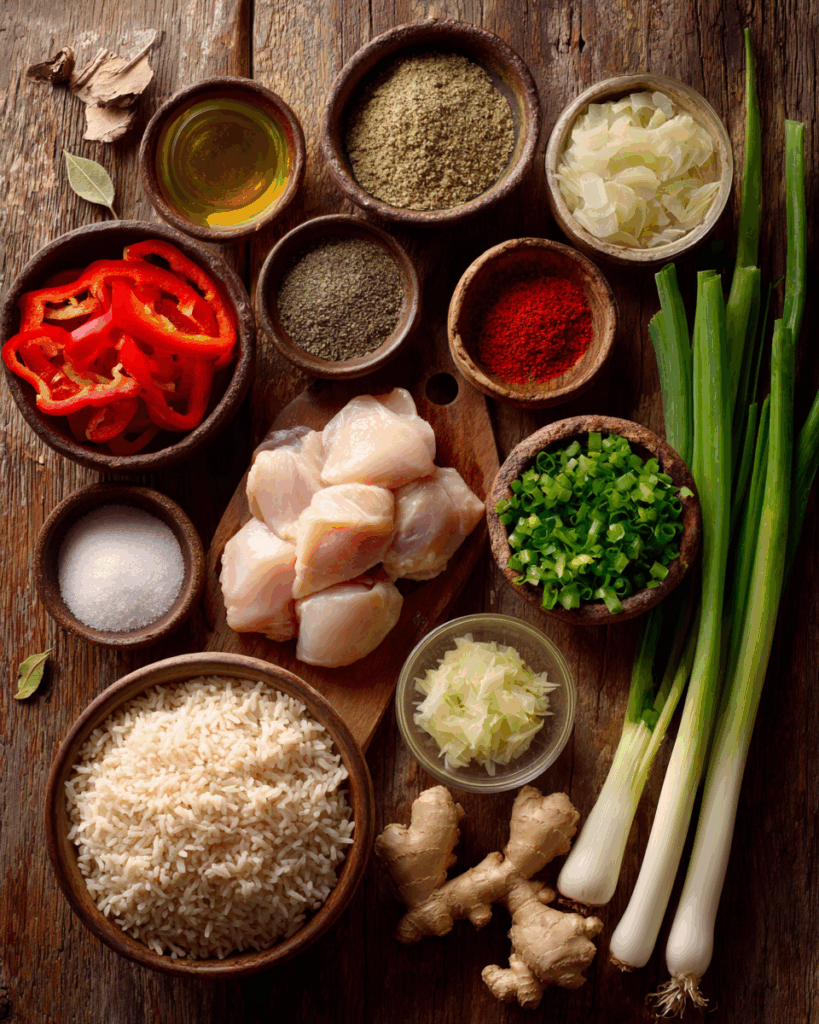
Creating a truly memorable Classic Thai Chicken Curry starts with choosing the right ingredients. Each component plays a vital role in building layers of flavor and texture, from the tender chicken to the creamy coconut milk. Let’s break down what you’ll need and why these ingredients matter.
Proteins and Vegetables
To keep this curry hearty yet balanced, use fresh, high-quality chicken and colorful vegetables.
- Chicken: 1 ½ pounds of boneless, skinless chicken breasts or thighs. Thighs offer a richer flavor and remain juicy during cooking, while breasts are leaner and cook slightly faster. You can also mix both for the best of both worlds.
- Red Bell Pepper: Thinly sliced, it adds sweetness and a pop of color that contrasts beautifully with the creamy sauce.
- Leek: Thinly sliced leeks bring a subtle oniony flavor that’s softer than regular onions, enhancing the curry’s aroma without overpowering it.
Aromatics and Flavor Builders
Aromatics are the backbone of Thai curries, infusing the sauce with deep, complex flavors.
- Garlic (2 cloves, minced): Essential for a savory base.
- Fresh Ginger (½ teaspoon, grated): Provides warmth and a hint of spice.
- Red Curry Paste (2 tablespoons): This is where the magic happens. Red curry paste combines chilies, lemongrass, galangal, kaffir lime peel, and other Thai staples into a concentrated flavor bomb. Look for a high-quality Thai brand for the most authentic taste.
Creamy Coconut Base
The soul of any Thai curry lies in its coconut milk.
- Full-Fat Coconut Milk (1 can, 14 ounces): Avoid light versions as they lack the fat content needed to create the signature creamy texture. Full-fat coconut milk not only thickens the sauce but also balances the heat from the curry paste.
- Coconut Oil (2 tablespoons): Used for sautéing the aromatics and chicken, it adds a subtle coconut aroma that ties the dish together.
Garnishes and Sides
Finish your curry with vibrant garnishes and serve with a perfect side.
- Fresh Cilantro (3 tablespoons, torn): Adds freshness and color to the finished dish.
- Prepared Brown Rice or Jasmine Rice: Ideal for soaking up the rich, flavorful sauce.
Don’t miss our Red Thai Crispy Chicken Curry That Tastes Better Than Takeout if you’re curious about another Thai curry variation that’s equally indulgent.
Step-By-Step Classic Thai Chicken Curry Recipe
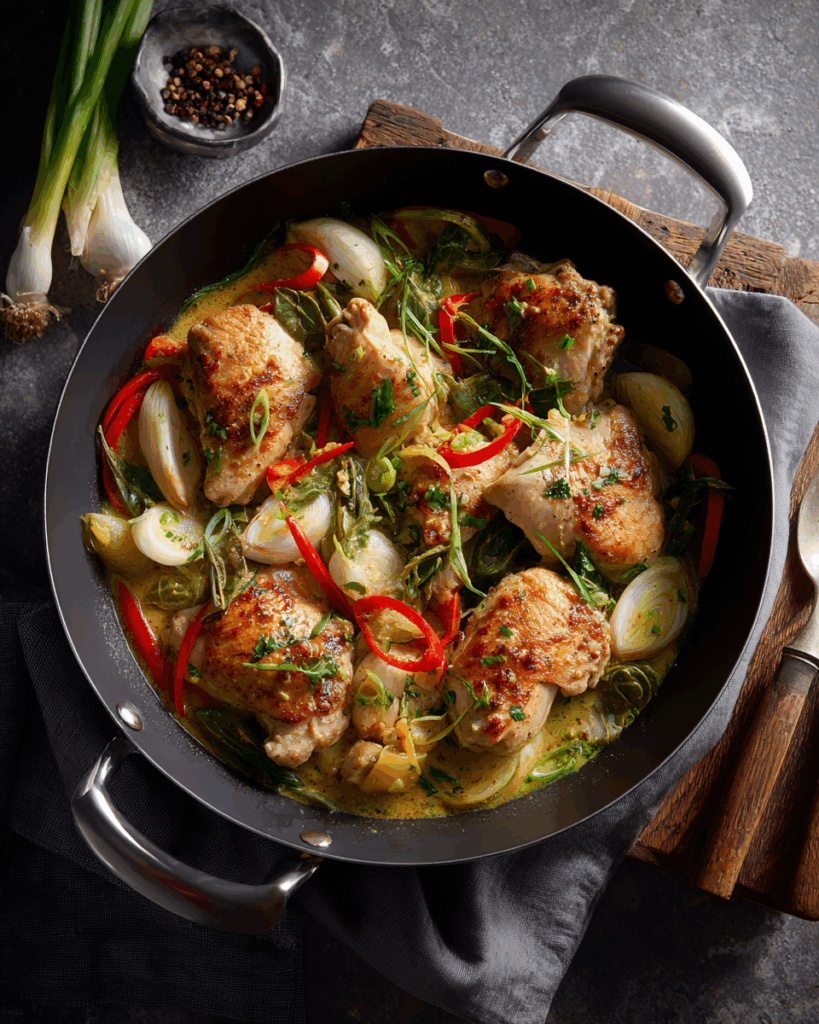
Cooking Classic Thai Chicken Curry at home is easier than you might think. With these clear steps, you’ll transform simple ingredients into a creamy, aromatic dish that rivals your favorite Thai restaurant.
1. Preheat and Season
Start by placing a rack in the center of your oven and preheating it to 375°F. Season 1 ½ pounds of chicken with ½ teaspoon kosher salt and ½ teaspoon ground black pepper. This simple seasoning ensures the chicken absorbs flavor during searing and baking.
2. Sear the Chicken
In a large ovenproof skillet, melt 2 tablespoons of coconut oil over medium-high heat. Add the chicken pieces and sear until both sides are golden brown. This step locks in juices and builds a flavorful base for your curry. Once seared, transfer the chicken to a plate.
For another take on searing and flavor-building, check out this Thai Chicken Curry recipe by Well Plated, which uses similar techniques for a rich, layered flavor profile.
3. Cook Vegetables and Aromatics
Lower the heat to medium-low. In the same skillet, add the sliced red bell pepper, leek, minced garlic, and grated ginger. Stir frequently and cook for about 2 minutes until the vegetables begin to soften and release their fragrance.
4. Add Red Curry Paste
Stir in 2 tablespoons of red curry paste and let it cook for 5 minutes, stirring often. This allows the paste’s flavors to bloom and infuse the oil, creating a deep, complex foundation for your sauce.
For an alternative approach using Thai red curry paste, explore RecipeTin Eats’ Thai Red Curry with Chicken, where the paste is fried first for maximum flavor.
5. Pour in Coconut Milk and Simmer
Gradually pour in 1 can (14 ounces) of full-fat coconut milk, stirring to combine. Make sure the curry paste dissolves evenly into the milk, creating a luscious, reddish-orange sauce. Return the chicken to the skillet, nestling it into the sauce so it’s partially submerged.
6. Bake to Finish
Transfer the skillet to the preheated oven. Bake for 25 minutes or until the chicken reaches an internal temperature of 165°F and the sauce has thickened slightly. Smaller chicken breasts may be done closer to the 15-minute mark, so check early to avoid overcooking.
Garnish generously with torn fresh cilantro and serve with warm jasmine or brown rice.
For a variation using Thai yellow curry paste and hearty vegetables, try Pinch of Yum’s Thai Yellow Chicken Curry with Potatoes. It’s a great alternative when you’re craving something milder yet equally comforting.
Secrets to a Perfect Thai Curry
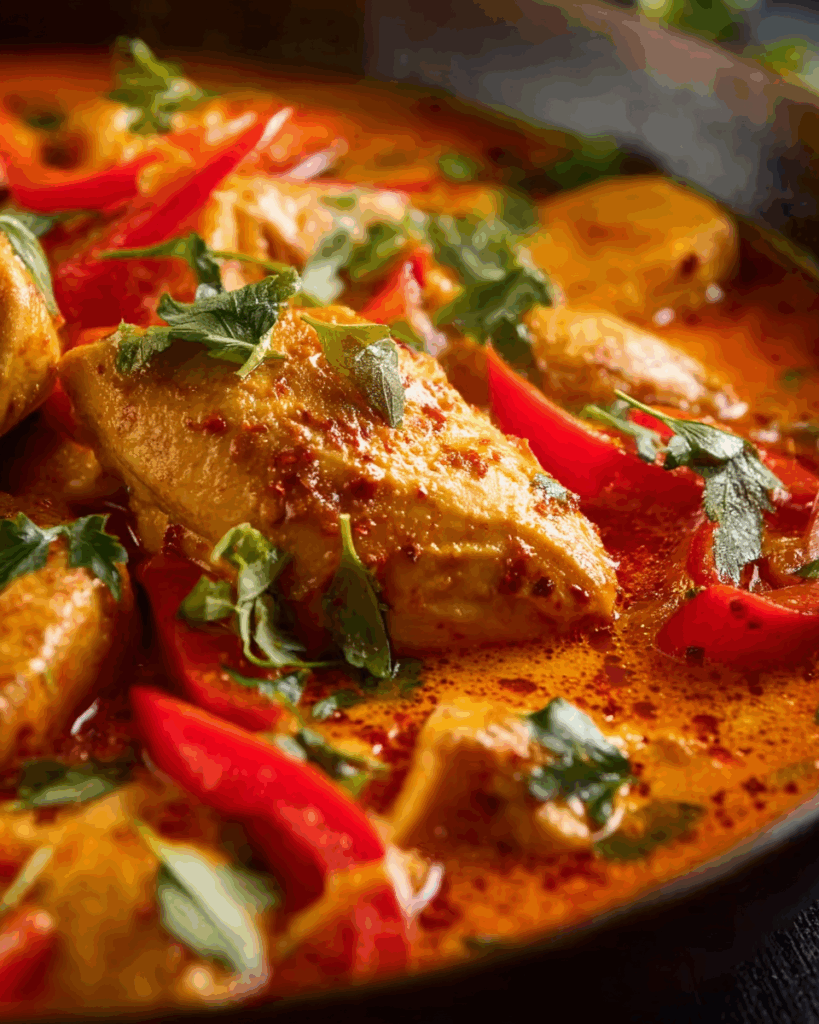
Always Use Full-Fat Coconut Milk
The secret to a luscious, velvety Thai curry lies in using full-fat coconut milk. Light coconut milk or coconut cream alternatives may sound appealing, but they lack the richness needed to create a thick, satisfying sauce. Full-fat coconut milk not only enhances the texture but also mellows out the spiciness from the curry paste, creating a harmonious balance.
Don’t Rush the Curry Paste
One of the most critical steps in Thai cooking is allowing your curry paste to bloom. When you sauté it gently in oil, the natural oils from herbs and spices like lemongrass, galangal, and chilies release their aromas and deepen the flavor profile. Rushing this step can lead to a flat-tasting curry.
Taste and Adjust as You Go
Thai cuisine is all about balance—sweet, salty, sour, and spicy working in perfect harmony. After adding your coconut milk, taste the sauce and adjust as needed. A splash of fish sauce can increase umami, a squeeze of lime juice brightens flavors, and a teaspoon of sugar can soften excessive heat. Trust your taste buds and make it your own.
Use Fresh Herbs for the Final Touch
Garnishing with fresh herbs like cilantro or Thai basil isn’t just for aesthetics. They add a pop of freshness and aroma that elevates the entire dish. Torn herbs scattered over the steaming curry right before serving create a sensory experience you won’t forget.
Common Variations of Thai Chicken Curry
One of the best things about Thai chicken curry is how versatile it is. By swapping curry pastes or adding different vegetables and proteins, you can create entirely new versions of this beloved dish. Here are the most popular variations that Thai food lovers often explore.
Thai Green Chicken Curry
This variation uses green curry paste, which has a herbaceous and slightly sweeter flavor profile compared to red curry. It gets its vibrant green hue from ingredients like green chilies, fresh cilantro, basil, and kaffir lime leaves. Adding vegetables like zucchini, eggplant, or bamboo shoots enhances its freshness, while tender chicken pieces soak up the mildly spicy, fragrant coconut sauce.
Thai Chicken Curry with Coconut Milk
For a creamier, milder curry, focus on balancing coconut milk and curry paste carefully. This version often leans toward a rich, velvety texture where the coconut milk dominates, giving the dish a slightly sweet taste that pairs beautifully with jasmine rice.
Thai Green Curry Recipe
This variation emphasizes the lighter and more herbal tones of Thai green curry paste. It’s ideal for those who prefer a fresh, aromatic curry with moderate heat. Often paired with chicken, shrimp, or tofu, this dish shines with plenty of fresh Thai basil and a hint of lime.
Easy Thai Green Chicken Curry Recipe
Perfect for busy weeknights, this streamlined version uses store-bought green curry paste and a handful of fresh ingredients. It delivers all the complex flavors of traditional green curry with less prep time, making it a favorite for beginners.
Thai Red Curry Recipe
This classic uses red curry paste, known for its bolder, slightly spicier flavor. The paste’s base of dried red chilies gives it a deep red color, while the coconut milk smooths out the heat. Adding vegetables like bell peppers and carrots creates a colorful, hearty meal.
Easy Thai Green Chicken Curry Recipe with Coconut Milk
This family-friendly variation combines the herbaceous notes of green curry with the sweetness of coconut milk for a mellow yet flavorful dish. It’s perfect for those who prefer a curry that isn’t too spicy but still packed with Thai aromatics.
Thai Red Curry Chicken and Vegetables
This hearty version pairs tender chicken with a medley of seasonal vegetables like broccoli, snap peas, and carrots. The creamy red curry sauce coats every ingredient beautifully, making it a comforting one-pot meal.
Thai Red Chicken Curry
Similar to the classic red curry, this version keeps it simple with just chicken and a few select vegetables. It’s all about letting the red curry paste and coconut milk shine without too many competing flavors.
Serving Suggestions and Pairings
A steaming bowl of Classic Thai Chicken Curry deserves the perfect accompaniments to elevate the dining experience. From fluffy rice to refreshing beverages, these pairings complete your Thai-inspired meal and turn it into an unforgettable feast.
Best Rice for Thai Curry
The velvety, aromatic sauce of Thai chicken curry begs for something to soak it up. Here are the best rice options to serve alongside:
- Jasmine Rice: This fragrant, slightly sticky rice is the classic pairing. Its subtle floral aroma perfectly complements the rich coconut sauce without overpowering the curry’s spices.
- Brown Rice: For a healthier option, brown rice adds a nutty depth and slightly chewy texture that works beautifully with the creamy curry.
- Sticky Rice (Glutinous Rice): While traditionally served with Northern Thai dishes, sticky rice is fun to enjoy with curry, especially when scooping up the sauce with your hands or forming bite-sized balls.
- Cauliflower Rice: If you’re looking for a low-carb option, cauliflower rice offers a lighter alternative without sacrificing the joy of soaking up the curry sauce.
To make your meal even more impressive, consider lightly toasting the rice in a pan before steaming it. This adds a subtle nuttiness that pairs beautifully with coconut-based curries.
Side Dishes to Complete Your Thai Feast
While your curry can stand alone as a hearty main dish, pairing it with light and flavorful Thai sides brings more dimension to your meal.
- Thai Cucumber Salad: Cool and refreshing, this salad balances the heat of the curry with a mix of crisp cucumbers, shallots, and a tangy vinegar dressing.
- Spring Rolls: Crispy vegetable or shrimp spring rolls make an excellent appetizer or side. Their crunch contrasts beautifully with the creamy curry sauce.
- Papaya Salad (Som Tam): A zesty, spicy, and slightly sweet salad that acts as a palate cleanser between bites of rich curry.
Drinks to Pair With
A spicy, coconut-rich curry pairs beautifully with beverages that cool the palate and refresh the senses. Consider serving one of these Thai-inspired drinks:
- Thai Iced Tea: This sweet, milky tea with a hint of vanilla perfectly balances the curry’s heat.
- Thai Iced Coffee: Bold coffee mellowed with sweetened condensed milk is a great option for coffee lovers.
- Coconut Water: Naturally hydrating, coconut water is a light and refreshing choice that complements the coconut flavors in the curry.
- Lemongrass Ginger Tea: A warm, caffeine-free herbal tea that soothes the palate and aids digestion after a flavorful meal.
Garnishes for the Perfect Finish
The final touches are as important as the cooking process. A sprinkle of fresh herbs or a squeeze of lime juice adds brightness to the rich curry.
- Fresh Cilantro or Thai Basil: Adds a pop of color and a burst of fresh, aromatic flavor.
- Lime Wedges: A squeeze of lime juice brings acidity that cuts through the richness of the coconut milk.
- Chopped Red Chilies or Chili Oil: For those who love heat, adding extra spice on top allows each diner to adjust the spice level.
- Toasted Coconut Flakes: Sprinkle lightly for a hint of sweetness and crunch that surprises with every bite.
Tips for Storing and Reheating

Classic Thai Chicken Curry isn’t just great for dinner—it makes fantastic leftovers. Knowing how to store and reheat it properly ensures every bowl tastes as fresh and delicious as the first. Here’s how to keep your curry’s flavors and creamy texture intact.
How to Store Leftovers
When stored correctly, your Thai chicken curry can provide quick, comforting meals throughout the week.
- Refrigeration: Transfer leftover curry into an airtight container once it has cooled to room temperature. Store it in the refrigerator for up to 3 days.
- Freezing: For longer storage, place cooled curry in freezer-safe containers or heavy-duty freezer bags. It freezes well for up to 3 months. Make sure to leave about an inch of space at the top of the container to allow for expansion as the sauce freezes.
- Portioning: Consider dividing the curry into individual servings before freezing. This makes it easier to thaw only what you need.
Best Practices for Reheating
The key to reheating Thai curry is doing it gently to preserve the delicate coconut milk sauce and prevent it from separating.
- Stovetop Method (Recommended): Place the curry in a saucepan over medium-low heat. Add a splash of water or coconut milk if the sauce has thickened during storage. Stir occasionally until the curry is heated through.
- Microwave Method: Place a portion in a microwave-safe dish, cover loosely, and heat on medium power in 1-minute intervals. Stir between each interval to distribute heat evenly.
- Avoid High Heat: High temperatures can cause the coconut milk to separate and become grainy. Always reheat gently.
How to Refresh the Flavors
As curries sit, their flavors tend to deepen, but they can also lose a bit of their brightness. To revive your reheated curry:
- Add a splash of fresh lime juice right before serving to bring back a zing of acidity.
- Garnish with freshly torn cilantro or Thai basil to restore that aromatic freshness.
- Adjust seasoning with a pinch of salt or a dash of fish sauce if needed.
With these tips, your leftover Classic Thai Chicken Curry can taste even better the next day, making it perfect for meal prepping or enjoying a cozy lunch at work.
Expert Tips and Serving Ideas for Classic Thai Chicken Curry
When it comes to perfecting Classic Thai Chicken Curry, a few insider tips and creative serving ideas can elevate this beloved dish from great to unforgettable. Whether you’re a seasoned cook or making Classic Thai Chicken Curry for the first time, these insights will ensure your curry rivals any takeout or restaurant version.
Master the Art of Balance
The beauty of Classic Thai Chicken Curry lies in its harmonious blend of flavors. Each element—spicy, sweet, salty, and sour—must be carefully balanced. For instance, if your Classic Thai Chicken Curry tastes too spicy, adding more coconut milk or a pinch of sugar can mellow the heat. If it’s too rich, a squeeze of fresh lime juice adds brightness that cuts through the creaminess.
Use High-Quality Coconut Milk
Always opt for full-fat coconut milk when making Classic Thai Chicken Curry. The richness of full-fat coconut milk gives Classic Thai Chicken Curry its signature silky texture. Light coconut milk or watered-down alternatives will leave your Classic Thai Chicken Curry lacking in depth and body.
Don’t Skip the Curry Paste Blooming Step
To achieve maximum flavor in Classic Thai Chicken Curry, take time to sauté the red curry paste in oil before adding coconut milk. This blooming step allows the spices and aromatics to release their oils, infusing your Classic Thai Chicken Curry with bold, authentic Thai flavors.
Add Vegetables for Color and Nutrition
While traditional Classic Thai Chicken Curry often includes red bell peppers and leeks, feel free to add a rainbow of vegetables. Baby corn, zucchini, carrots, and bamboo shoots not only add nutrition but also make Classic Thai Chicken Curry visually stunning.
Serving Ideas to Impress
Classic Thai Chicken Curry is incredibly versatile when it comes to serving. Here are some ideas to make your meal feel like a Thai feast:
- Serve Classic Thai Chicken Curry with warm, fluffy jasmine rice to soak up the luxurious sauce.
- For a low-carb option, pair Classic Thai Chicken Curry with cauliflower rice or zucchini noodles.
- Garnish your Classic Thai Chicken Curry with fresh Thai basil, toasted sesame seeds, or a drizzle of chili oil for an extra burst of flavor.
- Accompany Classic Thai Chicken Curry with Thai-style appetizers like spring rolls or papaya salad to create a complete meal.
Why Classic Thai Chicken Curry Is Perfect for Meal Prep
Another reason to love Classic Thai Chicken Curry is how well it stores and reheats. Make a large batch of Classic Thai Chicken Curry and store portions in airtight containers. The flavors often deepen after a day or two, making leftover Classic Thai Chicken Curry even more delicious.
Conclusion
Few dishes bring people together like Classic Thai Chicken Curry. With its creamy coconut base, tender chicken, and aromatic spices, it’s no wonder this curry has become a staple in kitchens around the globe. Whether you’re cooking it for a quick weeknight meal or a special family dinner, Classic Thai Chicken Curry delivers bold flavors and heartwarming comfort every time.
Remember, the beauty of Classic Thai Chicken Curry lies in its versatility. You can make it as spicy or mild as you like, add your favorite vegetables, or swap the chicken for tofu or shrimp. No matter how you customize it, the result is always a satisfying dish that’s rich in Thai flavors.
So gather your ingredients, take your time with the curry paste, and let your kitchen fill with the irresistible aroma of simmering coconut milk and spices. Once you master this recipe, Classic Thai Chicken Curry might just become your go-to comfort dish.
FAQs About Classic Thai Chicken Curry
What are the main ingredients in Thai curry?
The main ingredients in Classic Thai Chicken Curry are:
Curry paste (red for this version)
Coconut milk
Chicken
Fresh vegetables
Herbs like cilantro or Thai basil
Together, these elements make Classic Thai Chicken Curry one of the most beloved comfort foods worldwide.
What is the secret to a good Thai curry?
The secret to a flavorful Classic Thai Chicken Curry lies in three things: using fresh ingredients, blooming the curry paste in oil, and balancing flavors. Coconut milk provides a luscious texture, while a touch of lime juice and fresh cilantro at the end brightens the dish. A good Classic Thai Chicken Curry is all about harmony between sweet, salty, sour, and spicy elements.
What goes in a Thai chicken curry?
The essentials of a great Classic Thai Chicken Curry include:
Boneless, skinless chicken breasts or thighs
Full-fat coconut milk for a creamy base
Fresh aromatics like garlic and ginger
Thai red curry paste for a bold, spicy foundation
Colorful vegetables like bell peppers and leeks
These ingredients, combined with the right cooking method, make Classic Thai Chicken Curry a standout dish in Thai cuisine.
What is a traditional Thai curry?
A traditional Thai curry, like Classic Thai Chicken Curry, is a harmonious blend of fresh curry paste, coconut milk, vegetables, and protein. What sets Classic Thai Chicken Curry apart from other types is its balanced flavor profile—spicy, creamy, and slightly sweet. It’s prepared by sautéing curry paste in oil, adding coconut milk for richness, and simmering tender chicken until it soaks up all the aromatic flavors.
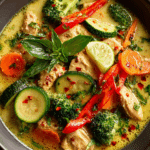
Classic Thai Chicken Curry
- Prep Time: 10 minutes
- Cook Time: 40 minutes
- Total Time: 50 minutes
- Yield: 4 servings 1x
- Category: Main Course
- Method: Baking
- Cuisine: Thai
- Diet: Gluten Free
Description
This Classic Thai Chicken Curry features tender chicken seared and baked in a fragrant coconut milk sauce with red curry paste, bell pepper, and leeks. Perfectly spiced and served over fluffy brown rice for a comforting and flavorful meal.
Ingredients
- 1 ½ pounds boneless skinless chicken breasts or thighs, or a mix
- ½ teaspoon kosher salt
- ½ teaspoon ground black pepper
- 2 tablespoons coconut oil
- 1 red bell pepper, thinly sliced
- 1 leek, thinly sliced
- 2 cloves garlic, minced
- ½ teaspoon grated fresh ginger
- 2 tablespoons red curry paste
- 1 can full-fat coconut milk (14 ounces)
- 3 tablespoons fresh cilantro, torn
- Prepared brown rice, for serving
Instructions
- Preheat the oven to 375°F (190°C) and place a rack in the center.
- Season the chicken with kosher salt and black pepper.
- Melt the coconut oil in a large, ovenproof skillet over medium-high heat. Sear the chicken on both sides until deeply golden brown, then transfer to a plate.
- Reduce heat to medium-low and add bell pepper, leek, garlic, and ginger. Cook for 2 minutes until slightly softened.
- Stir in the red curry paste and cook for 5 minutes, stirring often.
- Slowly pour in the coconut milk, stirring to combine. Return the chicken to the skillet.
- Transfer the skillet to the oven and bake for 25 minutes, or until the chicken reaches an internal temperature of 165°F (74°C) and juices run clear. Smaller pieces may finish around 15 minutes.
- Top with torn cilantro and serve with brown rice, spooning the coconut curry sauce over the top.
Notes
- For a vegetarian option, substitute chicken with firm tofu or chickpeas.
- Adjust the spiciness by adding more or less red curry paste to taste.
- Use light coconut milk for a lower-calorie version, though the sauce will be thinner.
Nutrition
- Serving Size: 1 serving
- Calories: 450
- Sugar: 5g
- Sodium: 780mg
- Fat: 26g
- Saturated Fat: 18g
- Unsaturated Fat: 6g
- Trans Fat: 0g
- Carbohydrates: 18g
- Fiber: 3g
- Protein: 38g
- Cholesterol: 110mg
Keywords: Thai chicken curry, coconut milk curry, easy Thai dinner, gluten free Thai curry


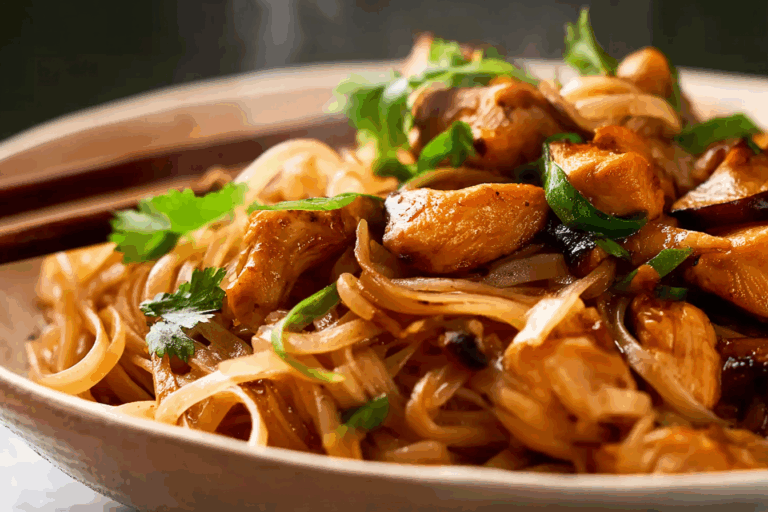
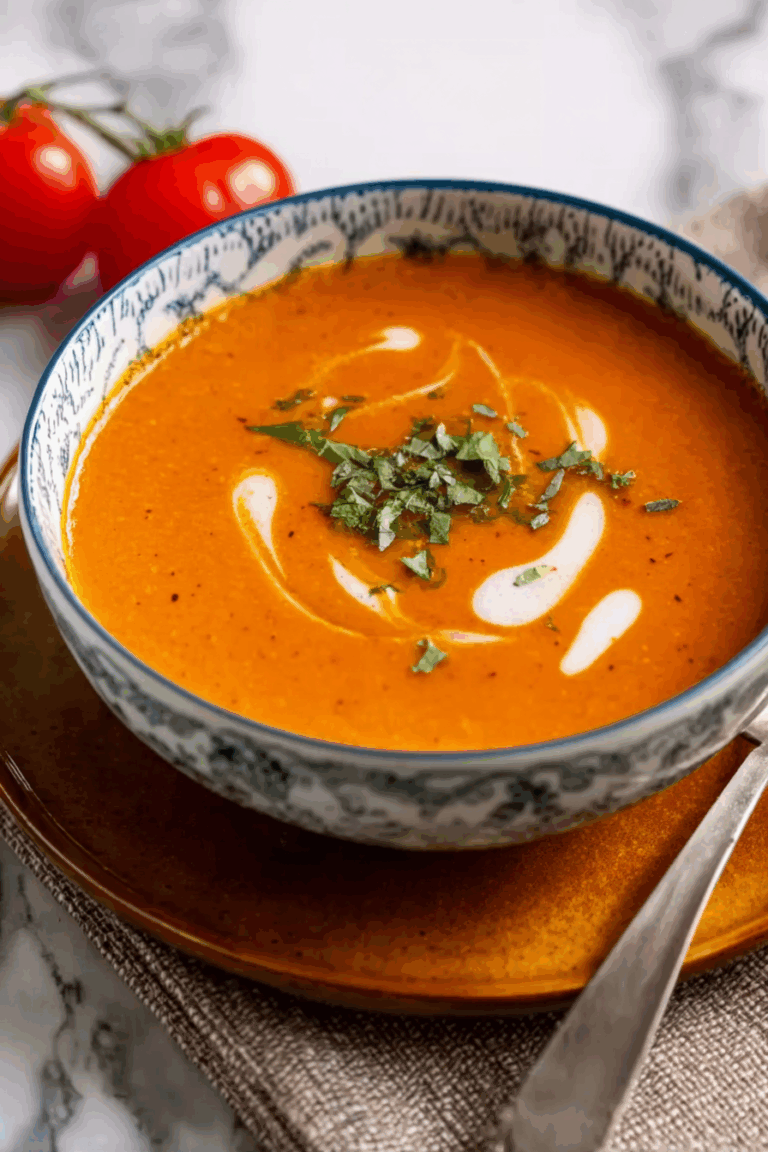
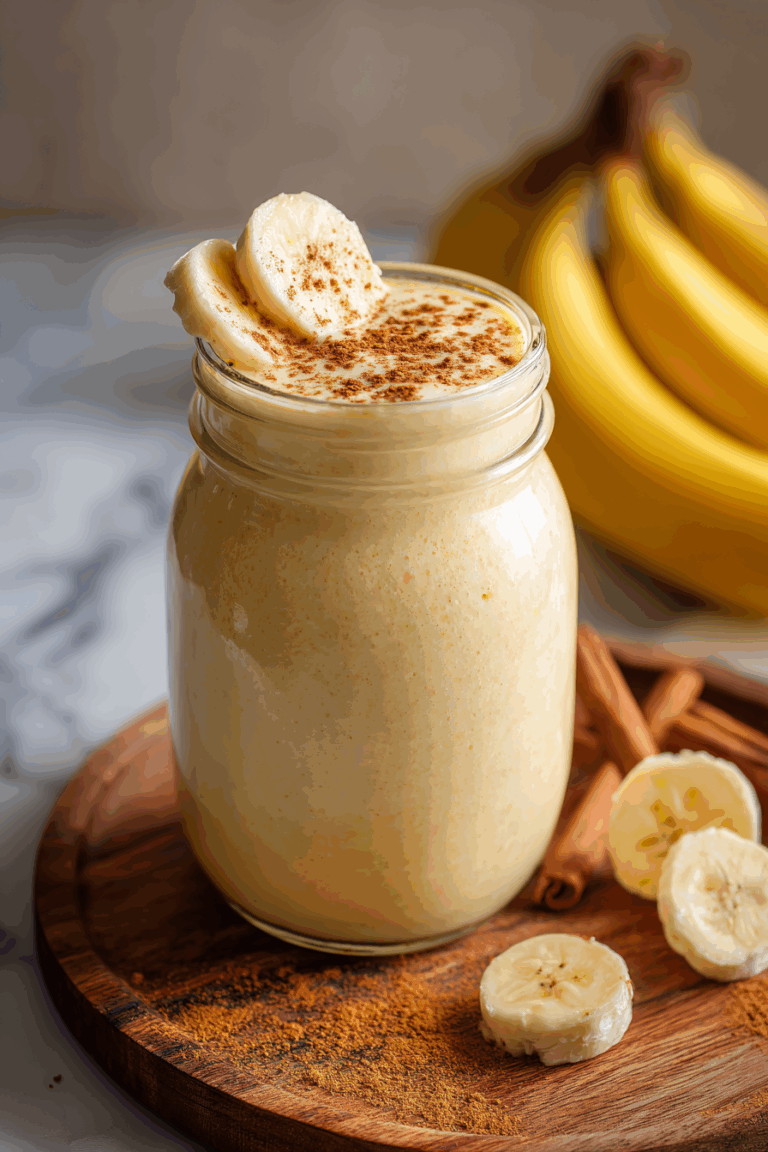
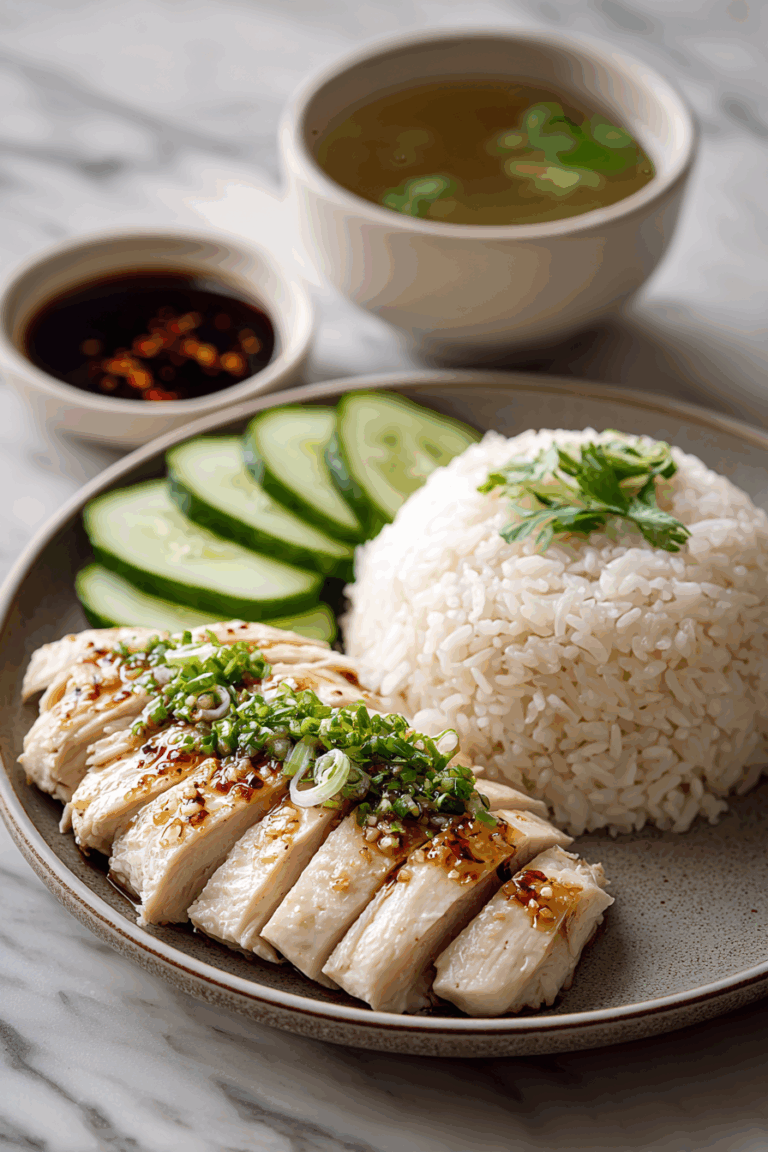
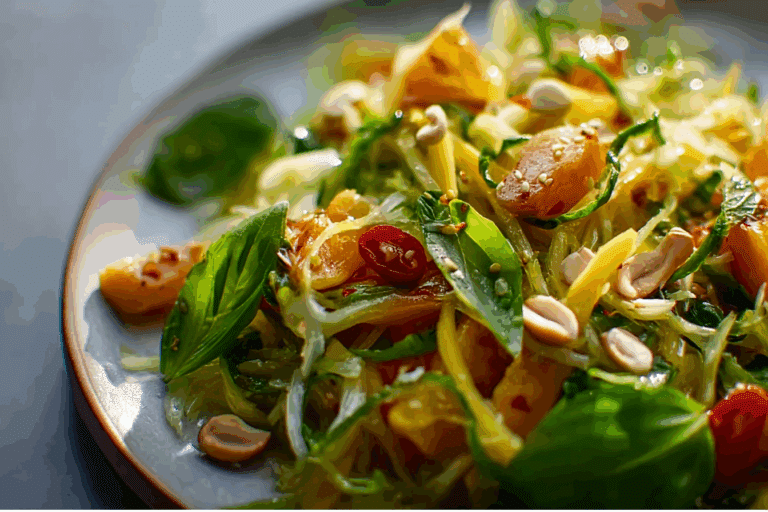
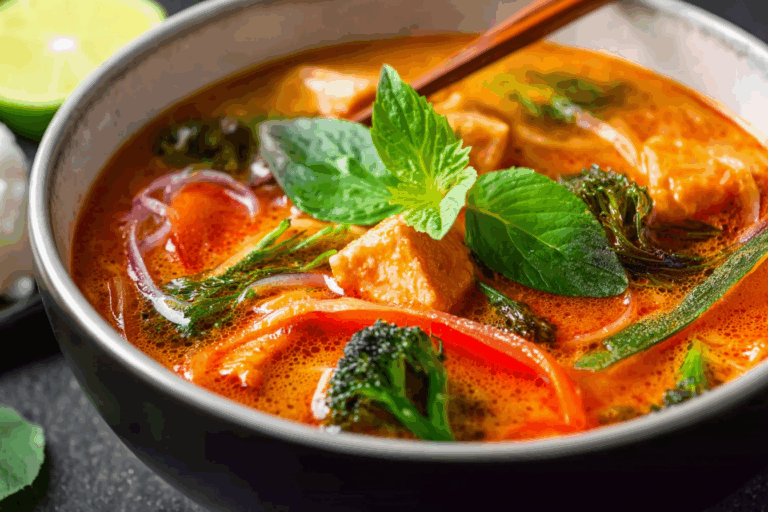
Thanks for another fantastic post. Where else could anyone get that kind of info in such a perfect way of writing? I’ve a presentation next week, and I am on the look for such info.